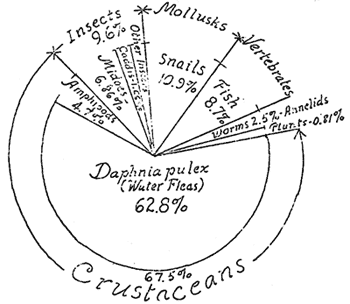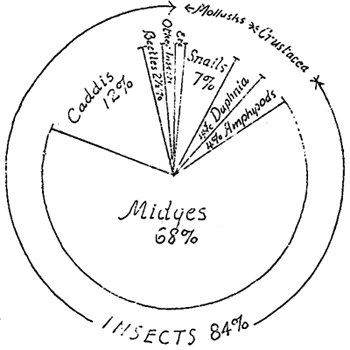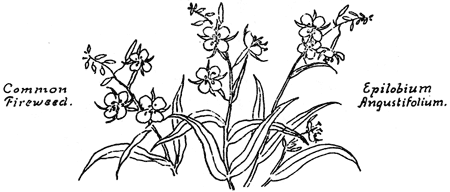Latest Flowering Plants in Crater Lake National Park
By Elmer I. Applegate, Ranger-Naturalist
In common with other regions of high altitude, the flowering time for plants in the Park is relatively short. The seasons vary greatly, depending largely upon the snowfall. While nearer normal, the present is at least a month later than last year.
The earliest flowers to appear are normally in the lower levels. Many of these have a comparatively longer flowering season and a greater altitudinal as well as geographical distribution, following up to higher levels with the advance of the season. Of these,Phlox Douglasii (Douglas’s Phlox) is a noteworthy example. In the Lava Beds Monument it was out during the month of May; a month later it was in flower in the yellow pine zone of the Park, and late in July it was in all its glory on the lower slopes of the Watchman and the pumice fields to the north and westward. Even as late as the middle of August this ubiquitous plant will follow the last of the lingering snow-drifts farther up the slope.
Of the earliest and more fleeting flowers to appear in the hemlock zone, might be mentioned the yellow Erythronium (E. grandiflorum pallidum) which adds much to the floral beauty of Sun Creek Valley, and the Western Windflower (Anemone occidentalis),so attractively decorating the first bare spots at the entrance of Castle Creek Garden. In their restricted habitats, they come immediately after the disappearance of the snow, and follow closely the retreating drifts, their season being regulated by the depth.
A number of the more conspicuous plants are not in flower until the season is considerably advanced, or even well into the second half. These, for the most part, continue to flower until early snowfall. As common elsewhere, members of the Aster family dominate. Of these, one of the most widely distributed and attractive perennials is Engelmann’s Aster, sometimes know as Colville’s Aster. The many tall leafy stems form large rounded or spreading clumps. By the latter part of August the purple flower-heads will add much to the color of the pumice flats and slopes, notably about Government Camp and the Rim area. Intermingled with it, or dominating some areas, will be bright golden-yellow spots and patches of Bloomer’s Rabbit Brush(Chrysothamnus bloomeri). In less abundance is the gray-leaved Rabbit Brush (C. nauseosus speciosus). On the slopes of Garfield Peak it can be seen along the trail. Just at this time one of the most attractive of the late bloomers is the Western Boneset(Eupatorium occidentale). This, with its many-stemmed pink or lavender-colored flower-heads, is rather abundant and especially noticeable on the lava flows of Wizard Island, and more common along the rocky lake shore at the Wine Glass. Everywhere on the pumice fields of the upper areas, is the Pyrola-leaved Eriogonum (E. pyrolifolium).By the first of August, the tall corn-like stalks of the green False Hellebore (Veratrum viride) with their panicles of greenish-white flowers will be much in evidence, and the pink-flowered common Fireweed (Epilobium angustifolium) will be at its best. The Silver Plant (Raillardella argentea) forms shining silvery mats on the higher summits. More rare and seldom seen by visitors to the Park, are the bog-loving Parnassia intermediawith its white buttercup looking flowers, and the beautiful little gentian (Gentiana simplex). with its single deep blue flower. These two plants are to be found at Boundary Spring and Copeland Creek. It is interesting to note that the common sagebrush(Artemisia tridentata) which contributes so much to the gray color of the plaints and deserts of the west, occurs on the dry talus slope of the crater wall at the Wine Glass. There it is associated with the yellow pine and other plants of the Transition life zone. It will not be in flower before the last of August, which is about the time it will be out in the Lava Beds area.
Food Habits of Crater Lake National Park
By J. S. Brode, Ranger-Naturalist
 One way of determining the life forms of a lake is by noting the food of the fish. During the last three weeks of July and the first week of August, fifty fish stomachs received from fisherman from the lake were examined and their contents noted. All but four of these fish were Silverside trout averaging sixteen and a half inches in length; the four were small Rainbow trout. In examining the contents of the stomachs one is impressed by the fact that the diet of a particular individual is apt to be of one kind of food rather than from a wide range of kinds. For example, one fish will have concentrated on snails, one on midges, one on water fleas, and one on water-stranded land insects, or perhaps on worms. The largest individual form found was a seven-inch fish; the smallest individual used for food (exclusive of forms such as diatoms which are basically food of the fish food) is the water flea of Daphnia pulex (fig. 1). This minute crustacean was found in 74 percent of the fish examined and made up 62.8 percent of volume of food eaten by the fifty trout. These forms are rarely found at the surface of the lake, being most abundant at depths of 75 to 200 feet. The closely related Amphipod (fig. 2) locally known as fresh-water shrimp which is fairly abundant in the marginal waters of the lake is sixth in importance as fish food; it was found in 24 percent of the stomachs and made up 4.7 percent of the volume of food used by the fifty fish.
One way of determining the life forms of a lake is by noting the food of the fish. During the last three weeks of July and the first week of August, fifty fish stomachs received from fisherman from the lake were examined and their contents noted. All but four of these fish were Silverside trout averaging sixteen and a half inches in length; the four were small Rainbow trout. In examining the contents of the stomachs one is impressed by the fact that the diet of a particular individual is apt to be of one kind of food rather than from a wide range of kinds. For example, one fish will have concentrated on snails, one on midges, one on water fleas, and one on water-stranded land insects, or perhaps on worms. The largest individual form found was a seven-inch fish; the smallest individual used for food (exclusive of forms such as diatoms which are basically food of the fish food) is the water flea of Daphnia pulex (fig. 1). This minute crustacean was found in 74 percent of the fish examined and made up 62.8 percent of volume of food eaten by the fifty trout. These forms are rarely found at the surface of the lake, being most abundant at depths of 75 to 200 feet. The closely related Amphipod (fig. 2) locally known as fresh-water shrimp which is fairly abundant in the marginal waters of the lake is sixth in importance as fish food; it was found in 24 percent of the stomachs and made up 4.7 percent of the volume of food used by the fifty fish.In point of total bulk, the snails come second in importance as food, as they make up 10.9 percent of the food eaten. The snail used most by the fish is Pompholexspecies? (fig. 3) the middle-sized form of the three Crater Lake snails. It was found in 22 percent of the stomachs examined.
The various forms of insects make up the third largest amount of fish food, 9.6 percent, and were used by 54 percent of the fishes. However 6.86 of the 9.6 was made up of midges, larvae, pupae and adult stages (fig. 4). In some cases these made up the entire stomach contents. Land insects, when stranded by adverse wind currents sometimes make up the food; one fish had 11 beetles, 1 moth, 1 grasshopper or cricket, an ant, 1 bee, 2 bumble bees, 2 true bugs, as well as adult and pupa stages of midges, 3 snails and 1600 Daphnia. Of the water insects other than midges the Caddis fly, especially in the larva (penniwinkle stage) (fig. 5) is quite a favorite of off-shore feeding fish. They made up 1.66 percent of the volume of fish food though found in but 14 percent of the fish. Mayflies also form part of the fishes’ diet (0.65 percent)
The annelids formed only 2.53 percent of the food mass. Three small leeches (38 inch) were noted, and one stomach was largely filled with 65 worms, smaller than the earthworm but closely allied to it. These worms have been found in muddy pools along the lake margin and also in bottom tows to a depth of 90 feet.
The two fishes found in the diet made up 8.7 percent of the total mass though found in only 4 percent of the fish stomachs. The distinguishable plant material was relatively small, being only 0.8 percent of the diet and consisted of leathery Nostoc, a blue-green algae (fig. 6) and wads of filamentous green algae, probably Zygnema(fig. 7).
| Number of specimens |
Percent of total volume |
Fish eating number specimens |
|
| CRUSTACEANS | |||
| Amphipods | 1081 | 4.7 | 12 |
| Daphnia | 57657 | 62.8 | 37 |
|
58738 |
67.5 |
||
| INSECTS | |||
| Midges | 3018 | 6.86 | 22 |
| Caddis | 34 | 1.66 | 7 |
| May fly | 149 | .65 | 4 |
| Beetles | 19 | .20 | 3 |
| Bee, Ant | 4 | .13 | 3 |
| Moth | 2 | .08 | 2 |
| True bugs | 2 | .02 | 1 |
|
3228 |
9.60 |
||
| ANNELIDS | |||
| Leeches | 3 | .026 | 1 |
| Worms | 65 | 2.49 | 1 |
| MOLLUSCS | |||
| Snails | 399 | 10.9 | 11 |
| FISH | |||
| 2 | 8.7 | 2 | |
| PLANTS | |||
| Blue-green algae (Nostoc) | 12 balls | .26 | 2 |
| Green filamentous algae (Zygnema) | 6 cc | .55 | 2 |

Food of Crater Lake Fish (46 Silverside Trout and 4 Rainbow Trout). Reported by J. S. Brode, Aug. 1935.

Food of Crater Lake Fish (for the most part Rainbow Trout) as reported by C. Anderson Hubbard the seasonof 1933.
***previous*** — ***next***


